Yorkshire (East Riding)
YORK
The uniquely splendid Minster, largely intact city walls and a wealth of medieval churches make York the main tourist destination in the north of England. Modern attractions like the Jorvik Viking Centre and the National Railway Museum also help to swell the ranks of visitors.
In 314, one of three English bishops who attended the Council of Arles came from York and is traditionally called Eborius. Little is known of the church at that time or for the next three hundred years, but the beginning of York's role as a major Christian centre can be dated precisely to the baptism of King Edwin of Northumbria on Easter Day 627. We tell the story briefly below but more detail is given in the page on Northumberland.
Paulinus had been sent to Kent from Rome in 601 to assist Augustine in the conversion of the Saxon kingdoms of England. In 625, he undertook a mission to Northumbria, taking with him Ethelburga, daughter of King Ethelbert of Kent, as a Christian bride for the pagan King Edwin. Ethelburga had agreed to the marriage on condition that she was allowed to practise her Christian faith. After much deliberation with Paulinus, Edwin himself embraced the new teaching and was baptised with many of his relatives and followers, including his thirteen-year-old great niece Hilda, who later founded the monastery at Whitby.
Bede tells the charming story of Paulinus debating matters of faith with Edwin and his nobles in a Saxon banqueting hall. Eventually one man stood up and compared the life of a man to a sparrow's flight across the hall, entering through the eaves at one end and disappearing into the night at the other. Anything that could throw light on the fate of man after death was to be welcomed. This seemed to settle the argument and Edwin's pagan priest Coifi was one of the first to accept the new faith, riding out forthwith to destroy his temples and altars.
York Minster
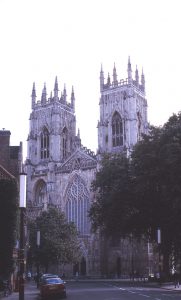
York Minster
The present Minster is the fourth to stand on the site. Construction was begun in 1220 and not completed until 1475. Its principal features are the magnificent West Front, massive central tower and an area of medieval stained glass which probably exceeds that found in the rest of England combined. For these and other features, the official guide books should be consulted.
The excellent exhibition in the Undercroft provides such evidence as there is of the early history of the church in York. The present outline of the Minster stands on a corner of the former Roman basilica, whose foundations can still be seen here. There is also a Roman culvert still carrying a stream of water into the River Ouse. Nothing remains of Edwin's church, which was probably made of wood, but it is not stretching the imagination too far to assume that it was in these waters that Edwin and his followers were baptised. There is also a dried-up well which is sometimes taken as the traditional site of baptism. The exhibition includes Saxon crosses and gravestones and even the base of a Roman column from a fourth century building on the site. The Undercroft also reveals the massive concrete buttresses used to underpin the central tower when it was found to be in danger of collapse in the 1960s.
A few years after Edwin's conversion, Christianity in Northumbria suffered a severe setback. At the Battle of Hatfield Chase in 633, Edwin was defeated and killed by the combined armies of two pagan kings, Penda and Cadwalla. Paulinus had to flee back to Kent with Ethelburga and her children. However the new faith had not been extinguished. Bishops and archbishops of York are listed on a board at the west end of the Minster. After Eborius in 314, the next three were Paulinus (627-633), Chad (664-669) and Wilfrid (669-677). These were energetic men whose labours took them to many parts of England. After the flight of Paulinus, there was an interval with no bishop until Wilfrid was appointed to succeed him, but he was away for so long being consecrated that Chad stepped in to fill the gap. During his period of office, Wilfrid was involved in a long dispute to change the centre of his diocese from Lindisfarne to York.
Among subsequent archbishops, the best known is Henry VIII's henchman Cardinal Thomas Wolsey, who held office from 1514 to 1530. In the twentieth century, four archbishops, William Temple, Cosmo Gordon Lang, Michael Ramsey and Donald Coggan, all went on to Canterbury as Primate of All England.
In Minster Yard, close to the main visitors' entrance, there is a statue of Constantine (c 274-337), who was in York when he was proclaimed Emperor of Rome in 306 on the death of his father Constantius. He is shown seated, with one arm draped over the back of his chair and the other resting on his sword, whose tip lies broken on the ground. At the Battle of Milvian Bridge in 312, Constantine had a vision of the Cross with the message In this Sign, Conquer. The validity of this experience has been much debated, but in 313 he issued the Edict of Milan, which ended the persecution of Christians and gave full toleration to the church. For better or worse, it also led indirectly to the concept of Christendom where the objectives of the church became increasingly identified with those of the state and vice versa.
On the wall of what is now the Minster shop, there is a memorial plaque to Miles Coverdale (1488-1569), believed to be a native of York. Coverdale translated the first complete English Bible in 1535 and revised the Great Bible of 1539, much of which was used in the King James Version. From 1420 to 1810, this building housed York Minster library.
GOODMANHAM
Sitting astride the Wolds Way footpath, the village lies midway between York and Hull. The church of All Hallows (YO43 3JB) stands on the site of a pagan temple, where King Edwin's chief priest Coifi once officiated. During the mission of Paulinus in 627, Edwin and his followers cautiously accepted the truth of the new faith and abandoned their pagan beliefs. Still worried about the consequences of renouncing paganism, Edwin asked for a volunteer to destroy the old shrines and altars. Coifi eagerly stepped forward and, leaping onto a horse, rode out to the temple, hurled a spear at the door and burned the building to the ground. The absence of any repercussions reassured Edwin, who was baptized with many of his followers.
HULL
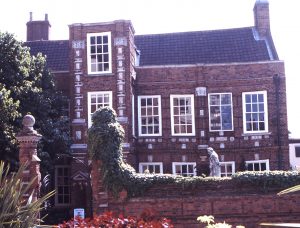
Wilberforce House
Strictly, of course, the town is Kingston-on-Hull, the river Hull a tributary of the mighty Humber estuary. The old part of the town, where the two rivers meet, retains its eighteenth century seafaring ambience, with pubs along the cobbled High Street called the Ye Olde Black Boy and the Sailmakers Arms.
For generations the Wilberforce family had lived in the town, growing wealthy in the timber trade with Scandinavia. Their home, the birthplace of William Wilberforce (1759-1833), backs directly onto the river and large ships still tie up just beyond the end of the garden. The house today is the centrepiece of Hull's Museums Quarter and has an exhibition of the life of Wilberforce and his campaign to abolish the slave trade.
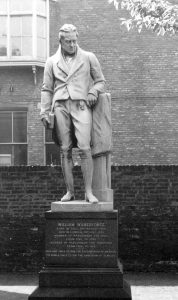
Statue of Wilberforce
Wilberforce House (HU1 1NQ) is late Elizabethan, probably built by John Lister and it remained with the Lister family until 1732, when it was acquired by Wilberforce's grandfather. The statue of Wilberforce in the front garden carries the rather prim inscription England owes to him the reformation of manners. The world owes to him the abolition of slavery. He became Member of Parliament for Hull from 1780 to 1784 and for Yorkshire from 1784 to 1812.
To illustrate the different periods in the history of the house, some rooms have the original seventeenth century oak panelling and ornate ceilings, while others are furnished in the style of a Georgian parlour and a Victorian drawing room. On the main staircase is the famous painting of a West African slave market by F. A. Biard, which has been reproduced in many books on the subject.
A room upstairs is devoted to the history of the slave trade. Besides the grim hardware of the business - fetters, whips and branding irons - the most dramatic exhibit is a life-size model of part of the hold in a slaving ship, with the unfortunate victims chained four to each slatted bunk. Here too are diagrams and models used by Wilberforce in parliament to show sceptical colleagues how slaves were crammed into the holds.
Another room covers the life of Wilberforce - his education, family and parliamentary career. There are portraits, contemporary cartoons and a life-size wax effigy of the great man at his desk with quill pen and inkstand, candlestick and bookshelves.
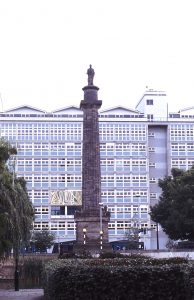
Wilberforce Monument
Elsewhere in Hull are other reminders of Wilberforce and the esteem in which he was held. After his death, he was hailed by the Victorians not only as Emancipator of the slaves, but also for his efforts to reform the "manners" (i.e. morals) of his generation. Wilberforce was no prude, but showed by his cheerful endurance of a painful disability and his happy family life that society could be changed for the better. Perhaps more than any other individual, his life exemplified the transition from the rakish Regency period to the thrift, energy and strong Christian values of the Victorians.
Immediately in front of Hull College and overlooking Queens Gardens is the Wilberforce Monument - reminiscent of Nelson's Column in Trafalgar Square. The citizens of Hull clearly wasted little time in creating a memorial to their most famous son. A panel on the back tells us that the first stone was laid on 1st August 1834, the day the act for the abolition of slavery came into force. Wilberforce had died just the previous year.
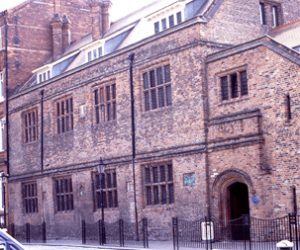
Old Grammar School, Hull
In Southchurch Side off Lowgate, alongside Holy Trinity Church, is a Tudor brick building which served as the Old Grammar School from 1583 to 1878 and is now a museum called Hands-on History (HU1 1RR). Former pupils include not only Wilberforce, but also his near contemporary Samuel Marsden (1764-1838) and the puritan poet Andrew Marvell (1621-1678), who also served as Hull's Member of Parliament. Marsden was a personal friend of Wilberforce, who encouraged him to accept the challenging post of chaplain to the penal colony in Australia.
The teachers at Hull Grammar School at this time were the energetic evangelical brothers Joseph and Isaac Milner. Joseph (1744-1797) also served as afternoon lecturer at Holy Trinity Church, one of the largest in England. Thousands flocked to hear his sermons, and in 1797 he was offered the living of Holy Trinity but died before he could take it up and is buried in the church. The font here is the one in which Wilberforce was baptized. Isaac Milner (1750-1820) was a lifelong friend and it was on a tour of the South of France in 1784-85 with his former teacher that Wilberforce, then a young MP, made his definitive Christian commitment which led to a lifetime of good works. Following his conversion, Wilberforce declined ministerial office but used his position and his influential friends, including the young Prime Minister William Pitt, to promote a host of worthy projects.
POCKLINGTON
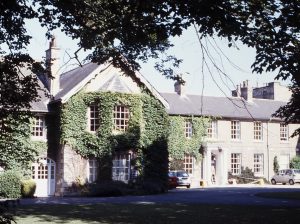
Pocklington School
Two places on the road to from Hull to York have further reminders of William Wilberforce. Wilberfoss is the village from which the family took its name, but William's ancestors had lived in Hull for several generations. The church records that a Christopher Wilberfoss gave money to repair the organ in 1533.
From 1771 to 1776, Wilberforce attended the grammar school at Pocklington. At the time it was a run down Dickensian establishment with about thirty pupils and he recalled ...I did nothing at all there. Today Pocklington School (YO42 2NJ) in Railway Street near the centre of the village is independent, co-educational and much expanded - its grey stone frontage largely covered with creeper. It is hard to discern which parts date back to the eighteenth century, but perhaps the old bell beneath its lead cupola might once have summoned young William to his lessons. To commemorate the achievements of its former pupil, the school has a statue of a seated slave, with chains lying broken by his side.


